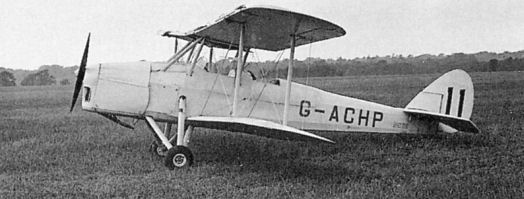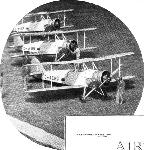
Описание
Страна : Великобритания
Год : 1933
Двухместный спортивный и учебный самолет
Варианты
- Avro - Tutor/Sea Tutor/Prefect / Type 621/646/626 - 1929 - Великобритания
- Avro - Cadet / Type 631/643 - 1932 - Великобритания
- Avro - Club Cadet / Type 638/639/640 - 1933 - Великобритания
Avro 638, Avro 639 и Avro 640 Club Cadet
В 1933 году фирма "Avro" представила вариант самолета Avro 631 Cadet, предназначенный для аэроклубов и частных лиц. Avro 638 Club Cadet отличался от 631-й модели складными крыльями бипланной коробки для упрощения размещения самолета в ангаре. В своей исходной форме машина выполнила первый полет в мае 1933 года, на ней стоял звездообразный двигатель Armstrong Siddeley Genet Major I. Однако пять самолетов, приобретенных "Airwork Flying Club", позже переоснастили 130-сильными моторами жидкостного охлаждения de Havilland Gipsy Major I. По спецзаказу был собран один самолет Club Cadet Special с мотором жидкостного охлаждения Cirrus Hermes IVA мощностью 140 л. с.
Варианты
Avro 639 Cabin Cadet: один самолет с закрытой трехместной кабиной (летчик впереди, два пассажира сзади)
Avro 640 Cadet: трехместный вариант с открытой кабиной для пилота (сзади) и двух пассажиров (бок о бок) в расширенной носовой части фюзеляжа; построено 9 машин - четыре с двигателем Hermes IV и пять с мотором Genet Major
ТАКТИКО-ТЕХНИЧЕСКИЕ ХАРАКТЕРИСТИКИ
Avro 638 Club Cadet
Тип: двухместный спортивный и учебный самолет
Силовая установка: один звездообразный двигатель Armstrong Siddeley Genet Major I мощностью 135 л.с. (101 кВт)
Характеристики: макс, скорость на оптимальной высоте 185 км/ч; крейсерская скорость на оптим. высоте 161 км/ч; дальность 523 км
Масса: пустого 564 кг; максимальная взлетная 907 кг
Размеры: размах крыла 9,19 м; длина 7,54 м; высота 2,67 м; площадь крыла 24,34 м2
Описание:
- Avro 638, Avro 639 и Avro 640 Club Cadet
- Flight, July 1933
THE NEW “AVRO-CADET" SERIES
Фотографии
-
Мировая Авиация 40
Регистрационный номер: G-ACHP [4] Этот Club Cadet G-ACHP в годы Второй мировой войны использовался фирмой "SAUNDERS-ROE" в качестве связного самолета.
-
Aeroplane Monthly 1992-07 / Personal album. Civil
Регистрационный номер: G-ACHP [4] The pride and joy of the Vintage Aeroplane Club was Avro 638 Club Cadet G-ACHP. Built in 1933, it was fitted with a Gipsy Major I and initially flown on communications duties by Saro.
-
Flight 1933-07 / Flight
Регистрационный номер: G-ACFH [3] WITH "HERMES IV": The three-seater "Cadet" can be supplied with this and similar in-line engines instead of the "Genet Major."
-
Jane's All the World Aircraft 1980 / Encyclopedia of Aviation - Aircraft A-Z - v2
Avro 638 Club Cadet.
-
Aeroplane Monthly 1983-02 / L.Curtis - Flying for all
Регистрационный номер: G-ACFH [3] Another popular Civil Air Guard type was the Avro Cadet. G-ACFH was a three-seater and the prototype Avro 640 Cadet.
-
Flight 1933-07 / Flight
Регистрационный номер: G-ACFH [3] The "Cadet" three-seater or joy-riding model. This particular machine has a "Hermes IV" engine.
-
Aeroplane Monthly 1986-07 / F.Bullmore - Circus Pilot (3)
Регистрационный номер: G-ACPB [5] Two of the three Avro Cadets attached to Cobham's National Aviation Day displays. The Cadet on the right nearly collided with an aircraft flown by the author near Inverness.
-
Aeroplane Monthly 1986-06 / F.Bullmore - Circus Pilot (2)
Регистрационный номер: G-ACLU [4], G-ACOZ [4], G-ACPB [5] The red, white and blue Avro Cadets were used for formation flying and for joyriding. For 7s 6d (38p) a seat the public could even take part in a Cadet race around a triangular course.
-
Aeroplane Monthly 1986-07 / F.Bullmore - Circus Pilot (3)
The red, white and blue Avro Cadets carried two passengers apiece.
-
Aeroplane Monthly 1986-06 / F.Bullmore - Circus Pilot (2)
Регистрационный номер: G-ACLU [4], G-ACOZ [4], G-ACPB [5] The Handley Page Clive G-ABYX leads the three Avro Cadets (G-ACLU, G-ACOZ and G-ACPB), Tiger Moth G-ACEZ and Ferry G-ABSI during the Grand Formation Flypast at Dagenham on April 14, 1934.
Другие самолёты на фотографии: Airspeed Ferry / AS.4 - Великобритания - 1932De Havilland Tiger Moth / D.H.82 - Великобритания - 1931Handley Page Hyderabad/H.P.24 / Hinaidi/H.P.33 / Clive/H.P.35 - Великобритания - 1923
-
Flight 1934-04 / Flight
Регистрационный номер: G-ACNY FOR TRANSPORTING THE S.O.S.: As we have already recorded, Lord Londonderry, the Secretary of State for Air, learnt to fly and obtained his "A" licence at Heston. He has now purchased through Henlys, Ltd., this Avro "Cadet" (Siddeley "Genet") for his own use.
-
Flight 1933-07 / Flight
Регистрационный номер: G-ACAY THE AVRO "CLUB CADET": The introduction of folding wings has necessitated the reduction, almost to vanishing point, of the heavy stagger of the Standard "Cadet." The engine is an Armstrong-Siddeley 7-cyl. "Genet Major."
-
Air-Britain Archive 1981-03
Регистрационный номер: G-ACTB A pre-war shot of Avro Club Cadet G-ACTB from Jim Halley's files.
-
Flight 1933-08 / Flight Advertisements
Регистрационный номер: G-ACHP [4] The Airwork School at Heston Airport, as the principal establishment of its kind in Great Britain, must naturally use the most up-to-date and efficient training aircraft. The school has, of course, been re-equipped with Avro Cadets.
-
Aeroplane Monthly 1986-05 / F.Bullmore - Circus Pilot (1)
Регистрационный номер: G-ACLU [4], G-ACOZ [4], G-ACPB [5] These three Avro Genet Major 640s gave formation flights during the years 1933-35, registered G-ACLU, G-ACOZ and G-ACPB, the red, white and blue aircraft were owned by the Scottish Motor Traction Company of Renfrew.
-
Flight 1933-08 / Flight Advertisements
Регистрационный номер: G-ACHN, G-ACHO, G-ACHP [4] -
Flight 1934-09 / Flight
ARDS OPENING: The scene in front of the clubhouse a few minutes before the Governor of Northern Ireland officially opened the airport. Lord Londonderry is at the microphone and Finian the White is on the left.
-
Air-Britain Archive 1986-01
Регистрационный номер: G-ACLU [4], G-ACOZ [4], G-ACPB [5] Yeadon on the occasion of the last National Aviation Display visit 14/15th September 1935. On the concrete apron are Moth G-AAJW and Puss Moth G-ABKG. The house on the right, below the apron, was multi-purpose with the manager's accommodation, club house and, in the annex, the passenger 'terminal'. Arrow Aircraft's factory was later built where the tents can be seen lower left. Visiting aircraft include from the bottom Avro 504N G-ADBD, Cadets G-ACOZ, G-ACPB, G-ACLU, Wessex G-EBXK, Tutor G-ABZP, a glider and a Dragon Rapide.
Другие самолёты на фотографии: Avro Avro 504N - Великобритания - 1920Avro Tutor/Sea Tutor/Prefect / Type 621/646/626 - Великобритания - 1929De Havilland Dragon Rapide / Dominie / D.H.89 - Великобритания - 1934De Havilland Gipsy Moth / Moth X - Великобритания - 1928De Havilland Puss Moth / D.H.80 - Великобритания - 1929Westland Wessex / Westland IV - Великобритания - 1929
-
Aeroplane Monthly 1979-02 / L.Curtis - Anything To Anywhere (2)
Philippa Bennett, at the age of 19, was one of the youngest members of the Civil Air Guard. She joined the ATA in June 1940 and ultimately became a Flight Captain cleared to fly four-engined aircraft.
-
Flight 1933-07 / Flight
FOR TAXI WORK AND JOYRIDING: In the "Cadet" three-seater the front cockpit has room for two, side by side.
-
Flight 1933-07 / Flight
Avro 638 Club "Cadet" 7 cyl. Genet "Major" Engine
-
Flight 1933-07 / Flight
Avro 640 3-seater "Cadet" 7 cyl. Genet "Major" Engine
- Фотографии





















